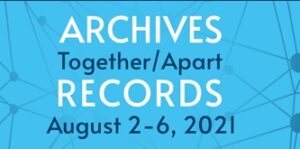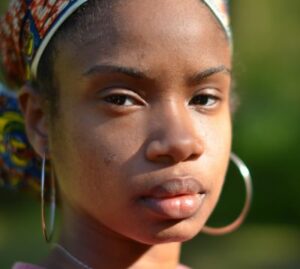By Sasha Jelan
Sasha Jelan is a 2020/21 Dance/USA Archiving & Preservation Fellow. Phase 1 of her Fellowship ran from June-September 2020, and was hosted remotely by Viver Brasil. For Phase 2 in the summer of 2021, Sasha is continuing her work with Viver Brasil, remotely and in site. Read more about the Fellowship program here. This is the fourth part of Sasha’s blog.
October 25, 2021: My First Society of American Archivists Annual Conference

This summer I was able to virtually attend the Society of American Archivist’s 2021 Annual Conference “Archives * Records: Together/Apart,” with the support of Dance/USA. Being that this was my first professional archives conference, I wasn’t sure what to expect or how to approach it. I found quickly that the process was fairly simple. Shortly after registration, I was given a schedule of upcoming presentations, and could add whichever presentations caught my interest to my agenda. There were so many interesting presentations offered, with topics ranging from “Outreach and Access for Smaller Institutions,” to “Storytelling Workshops.” Due to my current role as an Archiving & Preservation Fellow with Dance/USA, I chose to focus on presentations that addressed some of the challenges faced during the fellowship.
 There were two presentations that stood out to me: “Foundations for Culturally Competent, Racially Conscious Metadata” and “Pivoting During the Pandemic: Using Digital Tools to Process Archival Collections Remotely.” I felt that both addressed the culturally specific nature of my host company, Viver Brasil, and the rapid change endured in response to the COVID-19 pandemic.
There were two presentations that stood out to me: “Foundations for Culturally Competent, Racially Conscious Metadata” and “Pivoting During the Pandemic: Using Digital Tools to Process Archival Collections Remotely.” I felt that both addressed the culturally specific nature of my host company, Viver Brasil, and the rapid change endured in response to the COVID-19 pandemic.
Sam Winn and Dominique Luster presented “Foundations for Culturally Competent, Racially Conscious Metadata,” which discussed the ways in which description has historically perpetuated some of the racist or colonial narratives that are ingrained within western society. Working exclusively with Viver Brasil, an Afro-Brasilian dance company, it is crucial for me to ensure the accurate and just description of the materials I’m working with. One of the main points that Luster talked about was ownership: How do we encourage and hand over ownership of the collections we care for to the communities they represent?
One of the main ways Luster mentioned achieving this was through a term she describes as “Conscious Language,” which describes the represented communities in the language they use to describe themselves. For example, if a person of color describes themselves as a Black woman, it is okay and we are encouraged to describe that person as such. It adds to telling a full and rich history of that person.

Sasha Jelan (right) learning about Viver Brasil on a call with the founder, Linda Yudin (left)
A majority of the work done with Viver Brasil’s co-founding Artistic Director, Linda Yudin, was listening, and allowing Linda to tell the story of the materials we came across. Even as a Black woman, myself with lineage from the African Diaspora, I lacked the cultural competency to accurately describe the choreography, rhythms, dress, hierarchies, etc., that are held within this rich collection. I had to take a step back and literally become a transcriber, sorting through the descriptions and finding key subject headings (a specific word or phrase used to organize and label archival materials based on topic) and agents (an individual, family, or corporate entity), that are not readily documented in the “professional” and national databases used by the research community. Our circumstances are truly a gift. Not many archivists are given firsthand accounts and descriptions of the records they work with. They end up operating based on their personal experiences, which may not give the full scope of context and information provided in the record. If the description of the materials were left solely up to me, these records would be severely under-described and remain largely inaccessible, due to the lack of cultural competency. This further confirms the need for dance companies and cultural organizations to develop relationships with archivists, through collaboration, consultancy, fellowships, or on staff. Working in real time as records are created, with record creators authoring their own stories.
“Pivoting During the Pandemic: Using Digital Tools to Process Archival Collections Remotely” discussed the overall experience of the archives team at George Washington University processing a collection remotely. I found this presentation helpful as it was similar to my experience of the Archiving & Preservation Fellowship, and provided resources for approaching remote processing.
I found the digital tools that the GWU archives department used throughout the project to be most helpful, considering my experience as a fellow and for future projects. These included Google Sheets, Asana.com , Slack.com and Monday.com. Both Google Sheets and Slack, I had experience with in the past and used Google Sheets to create my spreadsheets for cataloging. Asana and Monday, however, were new to me and were two tools that could have been very beneficial during the planning and execution of this project. Asana.com is a project management tool, which allows users to set goals, build a project timeline, monitor progress, and meet deadlines. Monday.com is another project management tool, which offers a highly visual and user-friendly interface for setting and tracking a project workflow and progress. Both products offer free plans for individual users and small teams. Knowing about these tools earlier would have made the transition from in-person to remote processing smoother.
Overall, my experience at the SAA 2021 Annual Conference was rewarding. I saw what other archivists were doing and found applicable resources to my current practice. I would not only encourage fellow early career archivists to attend, but the general dance community as well. Much of what I learned was practical and can be incorporated into current practice as material is created.
 Sasha Jelan is currently pursuing a masters degree in Archival Studies at Clayton State University. She received her BA in Art at the University of Southern California’s Roski School of Art & Design, with an emphasis in photography.
Sasha Jelan is currently pursuing a masters degree in Archival Studies at Clayton State University. She received her BA in Art at the University of Southern California’s Roski School of Art & Design, with an emphasis in photography.
Sasha’s professional experience includes supporting the digitization and educational programming of institutions such as the Metropolitan Museum of Art and the Studio Museum in Harlem. Her archival practice is rooted in re-thinking and reclaiming the authorship and access of the African Diaspora.
Dance was a constant in Sasha’s youth, where she studied West African, Ballet and Modern dance techniques. Sasha is very excited to revisit the history of African Dance with Viver Brasil, and to support an organization whose mission closely aligns with her archival interests.
____
We accept submissions on topics relevant to the field: advocacy, artistic issues, arts policy, community building, development, employment, engagement, touring, and other topics that deal with the business of dance. We cannot publish criticism, single-company season announcements, and single-company or single artist profiles. Additionally, we welcome feedback on articles. If you have a topic that you would like to see addressed or feedback, please contact communications@danceusa.org.
Disclaimer: Opinions expressed in guest posts do not necessarily represent the viewpoints of Dance/USA.




